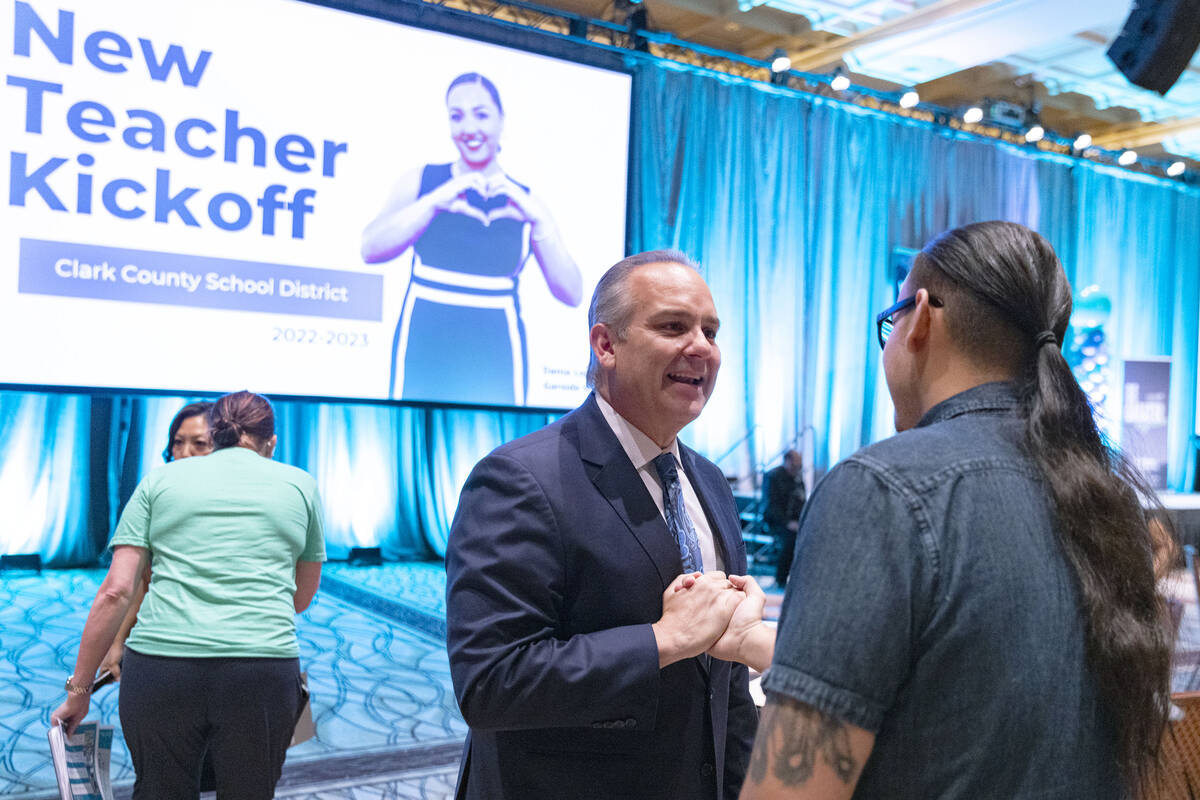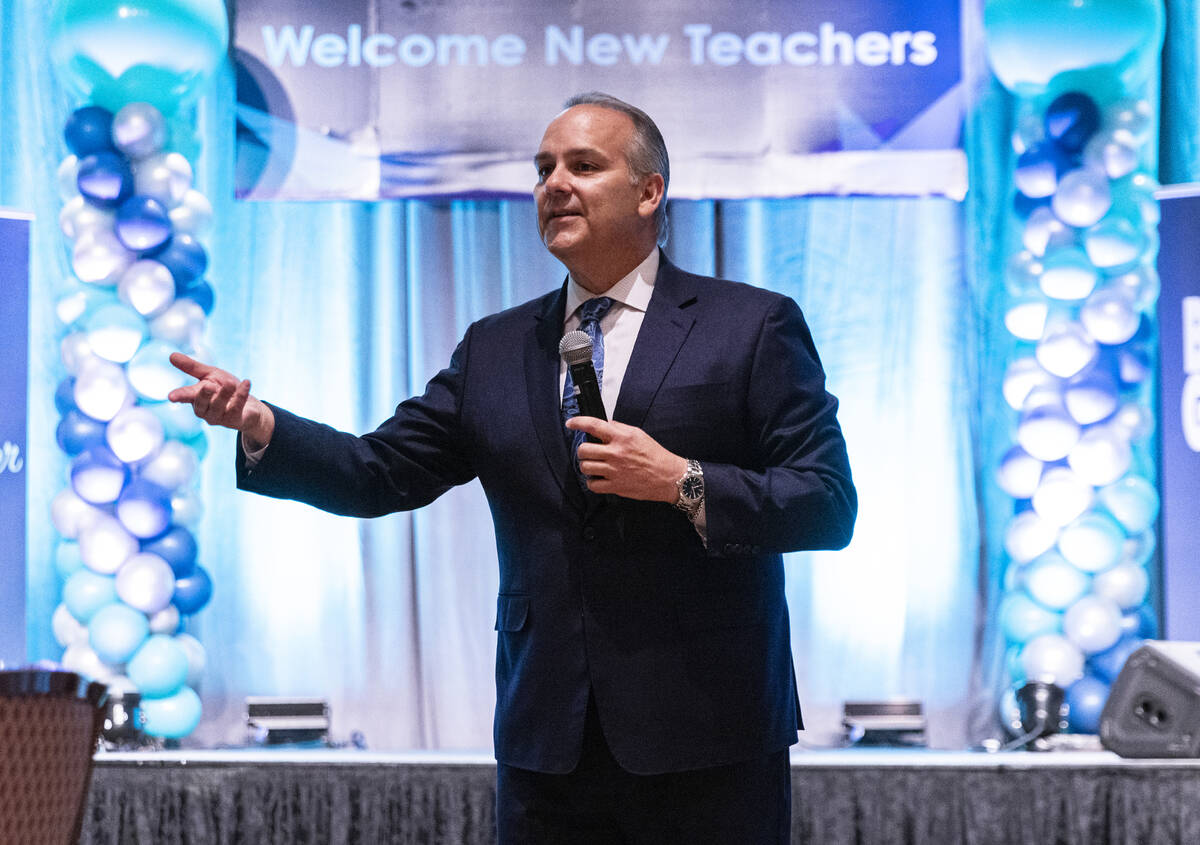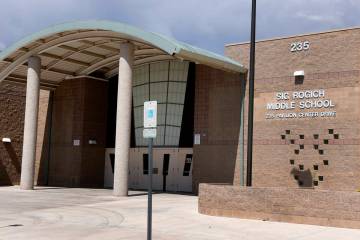CCSD working ‘feverishly’ to fill vacant teacher positions
The Clark County School District had 1,373 licensed job openings in mid-July — more than twice as many as previous years.
By comparison, that number hovered between 612 and 675 on similar dates in 2019, 2020 and 2021. The Las Vegas Review-Journal obtained the data through a public records request.
The nation’s fifth-largest school district, which has about 300,000 students, begins a new school year Aug. 8. Classroom vacancies could lead to larger class sizes, more classes covered by substitute teachers and fewer course offerings. The vacancies also could lead to teachers giving up their preparation time to handle additional classes.
According to a Thursday statement, the district will start the new school year with a licensed teacher in about 91 percent of classrooms. And it will have a school bus driver for approximately 90 percent of routes.
“CCSD recruits continually for all open positions and anticipates fill rates will improve throughout the school year,” the district said.
The district employs about 40,000 people and of those, more than 17,000 are licensed professionals, which include job categories such as teachers and school counselors. The district said Thursday it had hired 883 new teachers and 109 school bus drivers ahead of the new school year.
“We are excited to see so many new teachers joining CCSD in support of our students as we start the new school year,” Superintendent Jesus Jara said in the statement. “As staffing issues have affected every sector, we have worked feverishly to onboard new teachers over the summer and fill as many classrooms as possible.”
The district had 1,368 licensed vacancies in mid-May, and that increased to 1,431 by mid-June, according to data obtained through a public records request.
By mid-July, the number of openings dropped to 1,373. But overall, that’s five more than two months earlier.
The school district’s hiring website showed 1,453 licensed/certified job openings as of Friday.
As for classified jobs, the district had 1,478 openings in mid-July — about 100 fewer than mid-June, but several hundred more than mid-May.
That includes positions such as instructional assistants, campus security monitors, secretaries, and food service, transportation and custodial workers. Numbers provided by the district exclude student workers.
The district had 220 school bus driver vacancies in mid-July — a number that remained the same compared to similar dates in mid-May and mid-June, according to district data. The district was unable to provide comparison data for support staff vacancies from 2019, 2020 or 2021.
In June, the school board discussed staffing shortages and possible solutions. At the time, more than one-third of the district’s approximately 360 campuses had a teacher vacancy rate of 10 percent or higher, and 26 schools had a rate higher than 20 percent. That didn’t include special education vacancies.
The district also experienced staffing shortages last school year amid the COVID-19 pandemic. It took a “five-day pause” in January, which included two canceled school days tacked onto a long holiday weekend, due to a surge in coronavirus case numbers and uptick in absences.
Some educators have raised concerns at school board meetings for months about working conditions, including large class sizes and safety issues.
‘Doing everything we can’
The Review-Journal requested an interview with a district human resources representative about vacancy rates and was offered a chance one-and-a-half weeks later to ask questions along with other reporters during a new teacher kickoff event on Thursday at the Rio.
Chief Human Resources Officer Carol Tolx told reporters the district was still trying to fill around 1,300 teacher vacancies.
“But we’re really excited about that because partly what that shows is that our principals are trying to stick to low class sizes, so we are doing everything we can every day to help support them by hiring and digging for candidates everywhere we look,” she said.
Human resources representatives also meet with school principals on a regular basis to go over their staffing in order to support them directly, Tolx said.
In response to a question about why the number of vacancies has increased, Tolx said every school district has natural attrition, such as employees retiring, moving or leaving for personal reasons.
She said she would like to dig deeper into qualitative data to pinpoint the reasons they’re leaving so the district can work on those specifically.
Tolx said the district has been doing electronic recruitment to seek employees but needs to get back in person with people, noting she believes an in-person presence helps.
She said she’s sending a district team to a California event that more than 4,000 math teachers will attend, noting it will have a “big presence to capture as many as we can.”
‘Not competitive anymore’
At Tom Williams Elementary School in North Las Vegas, Principal Carrie Reasbeck said she thinks the situation with vacancies is a “multilayered problem” that’s similar for a lot of schools.
The campus was included in a list of schools with the highest vacancy percentages — information presented June 23 to the school board. As of June 1, the school’s vacancy rate was 20.93 percent, the 22nd highest in the district.
The vacancy rate hasn’t changed much since then and is now at 19.78 percent. The school has eight open teaching positions.
Reasbeck said the school’s location is not appealing to job candidates.
“They hear North Las Vegas, and they kind of run scared,” she said.
But she said she wants people to know that Tom Williams Elementary is “truly amazing” and a “hidden jewel.”
Almost every student lives in a single-family home, the transiency rate is low, and the school encounters few disciplinary problems, she added.
Reasbeck said she and her staff do their own recruiting by posting on social media websites in order to highlight the school.
She also participates in job fairs to try to recruit teachers but has received few candidates as a result.
“Las Vegas is just not competitive anymore, and you just can’t afford to live here,” she said.
The cost of living has gone up and is “ridiculous,” Reasbeck said, noting a $50,115 starting salary doesn’t go a long way when teachers are paying $1,800 a month for rent.
A school district recruiting website, though, touts Nevada’s cost of living, saying, “your salary will go even further.”
“We have NO state income tax, lower than average sales tax, and a cost of living that is lower than the national average,” according to the website.
At Tom Williams Elementary, another barrier to recruiting is an early start to the school day and teachers have to report at 7 a.m., creating a challenge for those with young children, Reasbeck said.
In order to handle vacancies for the upcoming school year, she asked for a volunteer among her current teachers to move to fourth grade and one educator “graciously accepted,” she said.
The principal said her staff is willing to adjust and do what’s best for students at all costs, noting she’s fortunate.
Reasbeck said her preference is to have a few more students in each classroom with a licensed teacher than to have a substitute pick up assignments.
If she can hire an additional teacher for a particular grade level in September or October, she’ll create an additional class at that point.
How other large districts are faring
Clark County isn’t the only large school district facing staffing shortages and vacancies.
“I think Clark County is not going to be unique in having challenges with staffing across the board,” said Ray Hart, executive director of the Council of the Great City Schools.
The Washington, D.C.-based organization represents more than 75 of the nation’s largest urban school districts, including the Clark County and Washoe County school districts.
School districts are experiencing “higher than traditional” staffing shortages at this point in the year, Hart said. Also, a larger number of teachers are stepping away from the profession, he added.
Hart said some districts represented by the council are seeing three to four times the number of vacancies this summer than what’s typical.
“For large, urban districts, that means a pretty good population of teachers,” he said.
Districts aren’t just facing teacher shortages, Hart said, but also in areas such as custodial staff.
Staffing challenges have been going on for a while, he said, including last school year. And they’re affecting many professions beyond education, he noted.
The Review-Journal reached out to a handful of large school districts nationwide seeking vacancy numbers but didn’t receive responses.
The Washoe County School District in the Reno area — which has about 62,000 students — had 4,068 certified employees and 240 certified vacancies as of mid-July, according to data provided to the Review-Journal.
“The Certified vacancies are fluid at this point however as schools are conducting many interviews and hires over the next several weeks,” district spokeswoman Victoria Campbell said via email.
The district had 217 bus driver positions filled and needed 43 more workers. And it had 2,089 classified employees — a number that doesn’t include bus drivers — and 203 vacancies.
Attracting and retaining teachers
The Clark County School District has taken steps to attract and retain employees, such as announcing in May it was raising starting teacher pay to $50,115 — an approximately $7,000 increase.
It has also authorized retention bonuses — the latest round totaling $4,500 to $5,000 in two payments for full-time regular employees.
And new teachers who move from more than 100 miles away are eligible for a $4,000 relocation bonus, according to the district’s Thursday statement. Those who receive it must commit to working for the district for three years.
The district said it also has increased pay for substitute teachers who take assignments at 218 Title I schools, which have a high percentage of students living in poverty, to between $150 and $200 a day, depending on the position. Pay for other substitutes starts at $110 a day.
As the district put out information about the substitute pay increase, the number of applicants increased, Tolx said Thursday.
She said she doesn’t think the school district is short on substitute teachers but didn’t have the exact number available for how many are in the pool.
As for school bus drivers, the district said in March it was increasing starting pay to $21.67 an hour and giving current workers a raise.
Tolx said Thursday the situation with hiring bus drivers is better than last year. She said vacancy rates are still fluid, and the district is working day and night to bring people in.
Some parents reported delays in bus service last school year, causing some children to arrive late to school.
In October 2021, the district announced a partnership with the Regional Transportation Commission to provide bus transportation for up to 4,000 students at 15 high schools.
And the district adjusted some school start and end times for the upcoming school year in an effort to improve on-time bus rates and boost efficiency.
Back at Tom Williams Elementary, Reasbeck said she thinks the public needs to be aware that school staffing shortages aren’t just affecting Clark County, but are happening everywhere.
“Teachers are definitely not paid their worth,” she said, adding that many college students aren’t going to choose a career in education.
Contact Julie Wootton-Greener at jgreener@reviewjournal.com or 702-387-2921. Follow @julieswootton on Twitter. Review-Journal photographer/videographer Rachel Aston contributed to this report.






























